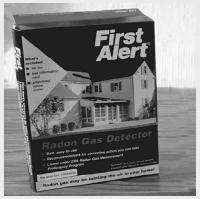Environmental Health - Radiation
Radiation is energy, or emission of energy, in the form of waves or particles. Microscopic particles, called atoms, are the foundation on which all matter (all substances that exist as solids, liquids, or gas) is built. Each atom has a nucleus at its center. The nucleus contains smaller (nuclear) particles called protons and neutrons. If the number, position, or energy level of these nuclear particles changes, an atom becomes unstable, or radioactive. Unstable atoms, or atoms undergoing change, produce radiation.
Sources of Radiation
Radiation is everywhere. It occurs naturally in soil and water on Earth. It exists in outer space and inside human bodies. Since the natural sources exist everywhere, these sources are sometimes called background radiation. There are human-made sources of radiation, too. Radiation has been harnessed for use in science, medicine, and industry. X-ray technology, nuclear power plants, and some forms of electricity use radiation. According to the United States Environmental Protection Agency (EPA), 80 percent of radiation sources are natural and 20 percent are synthetic (human-made).
Radiation: Words to Know
- Acid rain:
- Rain with a high content of sulfuric acid.
- Asbestos:
- A mineral fiber.
- Byproduct:
- Something other than the main product that is produced in a chemical or biological process.
- Carbon monoxide:
- A colorless, odorless, tasteless gas that turns into carbon dioxide when it is burned.
- Carcinogenic:
- Cancer-causing.
- Contaminate:
- To infect something or make something unsafe for use.
- Cosmic:
- Relating to the universe in contrast to Earth.
- Emission:
- Substances released into the air.
- Endocrine disrupter:
- Manmade chemical that looks and acts like naturally-occurring hormones.
- Environmental tobacco smoke (ETS):
- The mixture of the smoke from a lit cigarette, pipe, or cigar and the smoke exhaled by the person smoking; also known as secondhand smoke.
- Herbicide:
- A chemical agent used to kill damaging plants, such as weeds.
- Incinerator:
- A machine that burns waste materials.
- Industrial:
- Relating to a company that manufactures a product.
- Inert:
- A chemical agent lacking in active properties.
- Leaching:
- The process of dissolving outward by the action of a permeable substance.
- Lead:
- A heavy, flexible, metallic element that is often used in pipes and batteries.
- Microscopic:
- Invisible without the use of a microscope, an instrument that enlarges images of tiny objects.
- Nitrogen dioxide:
- A gas that cannot be seen or smelled. It irritates the eyes, ears, nose, and throat.
- Ozone layer:
- The atmospheric shield that protects the planet from harmful ultraviolet radiation.
- Particle:
- A miniscule pollutant released when fuel does not burn completely.
- Pesticide:
- A chemical agent used to kill bugs.
- Potassium:
- A chemical element that is a silver-white, soft metal occurring in nature.
- Radiation:
- Energy or rays emitted when certain changes occur in the atoms or molecules of an object or substance.
- Radon:
- A colorless, odorless, radioactive gas produced by the naturally occurring breakdown of the chemical element uranium in soil or rocks.
- Sulfur dioxide:
- A toxic gas that can also be converted to a colorless liquid.
- Synthetic:
- Something that is man-made; not found in nature
- Thyroid:
- A gland that controls the growth of the body
- Toxic:
- Relating to or caused by a poison
- Uranium:
- A chemical element that is a silver-white, hard metal and is radioactive.
- Volatile organic compound (VOC):
- An airborne chemical that contains carbon.
Types of Radiation: Non-ionizing and Ionizing Radiation
Two major types of radiation are non-ionizing radiation and ionizing radiation. Non-ionizing radiation is the less potent (strong) form. It has the power to move atoms around, but not to chemically change (or ionize) them. Ionizing radiation, on the other hand, does have the power to chemically change atoms and it is this power that makes it a threat to humans and the environment. There are three major types of ionizing radiation. They are called alpha, beta, and gamma rays. (They can also be described as radioactive particles, or radiation.) Each of these sub-groups is distinguished from the others by the ease or difficulty with which it can penetrate (or enter) the human body.
ALPHA RADIATION. The ability of an alpha particle to enter the body can be blocked by paper or skin, but alpha particles can enter the body through an open wound and do harm. Airborne alpha particles that are inhaled can cause serious lung damage.
BETA RADIATION. Paper cannot block beta radiation from entering the body. Some beta particles would be deterred by skin, while still more powerful beta particles would require something the thickness of wood to prevent entry. If beta rays do find their way into the body, they can get into the bones and cause damage.
COMMON SOURCES OF RADIATION TO WHICH PEOPLE CAN BE EXPOSED
- computer terminal
- cosmic rays from outer space
- ingested food and water containing elements like potassium
- medical X ray
- radiation in cancer treatment
- radon gas (in the air)
- rocks and soil
- smoke detector
- television
- X-ray luggage inspection machine
GAMMA RADIATION. Gamma rays are the most powerful particles. Often appearing along with alpha and beta rays, these dangerous rays can break through paper, skin, and wood. A concrete wall would be needed to deflect gamma rays. If gamma rays penetrate the body, they can cause major damage to internal organs.
Radiation Risks
Most scientists agree that radiation can be carcinogenic (cancer-causing); indeed, the major health risk radiation poses is an increased risk of developing cancer. Other harmful effects that have been observed include genetic abnormalities in the children of parents who had significant exposure to radiation. Mental retardation, in particular, has been observed in children whose mother was exposed to a significant amount of radiation.
EXPOSURE TO RADIATION, OR THE DOSE (AMOUNT) OF EXPOSURE, IS MEASURED BY A UNIT CALLED A REM. THE UNIT OF MEASURE FOR SMALLER DOSES IS THE MILLIREM. A REM IS EQUAL TO 1,000 MILLIREMS. ACCORDING TO EPA SCIENTISTS, AN AVERAGE U.S. CITIZEN'S ANNUAL RADIATION EXPOSURE IS ABOUT 360 MILLIREMS PER YEAR.

RADON AND ITS THREAT TO HUMAN LIFE
While cosmic rays represent some 8 percent of human exposure to natural radiation, EPA scientists suggest that radon accounts for an over-whelming 55 percent of human exposure to natural sources of radiation.
Produced by the decay of radioactive uranium (a chemical element) widely found in soils around the planet, radon gas has no color, taste, or odor. Radon travels up from the ground to seep into the foundation of a school, home, or other building. Once inside a building, airborne radon can become a threat to human health. If unhealthy amounts of radon are inhaled, it can damage the lungs and cause lung cancer. Scientists believe radon is second only to smoking as a cause of lung cancer, with thousands of lung cancer deaths in America each year thought to be the result of radon exposure.
Exposure to radioactive elements in the ground, such as thorium and potassium, can vary depending on where a person lives since the composition of land varies in different places. Exposure from cosmic radiation that is discharged into the atmosphere from outer space can also vary by location. Places that are at a higher elevation have thinner atmospheres and less protection from cosmic radiation. Locations that are closer to sea level have a bigger buffer zone and are less susceptible to cosmic radiation.
The Food and Drug Administration (FDA) and EPA insure that strict guidelines are followed for medical procedures involving radiation. The personnel, equipment, and facilities involved all have to meet certain standards to insure that radiation is managed as safely as possible. The Nuclear Regulatory Committee (NRC) has made tougher rules to govern construction, maintenance, emissions, and operations of nuclear power plants to decrease the risk of dangerous nuclear accidents. Stronger rules have also been developed for disposal of the radioactive waste, which is the byproduct of medical, scientific, and industrial uses of radiation.
What to Do About Radiation Exposure
Even with federal agencies monitoring radiation risks and working to control dangerous exposure to human populations and the environment, people still can't avoid radiation altogether. But precautions can be taken to limit exposure. When doctors recommend getting an X ray, people should not be afraid to take a few moments to talk about the risks versus benefits. Also, people in any community should be encouraged to get homes or schools tested to find out if the radon levels are acceptable.
There are three key strategies to limiting radiation exposure:
- Time spent near an identified source of radiation should be limited.
- Distance from an identified source of radiation should be kept; more distance means less exposure.
- Identified sources of radiation should be shielded, keeping them out of or away from the body where they can do damage; for example, cracks in pipes and foundations should be repaired to block radon from getting into the air of homes.
FEDERAL AGENCIES WORKING TO LIMIT RADIATION EXPOSURE
Environmental Protection Agency (EPA)
Nuclear Regulatory Committee (NRC)
Department of Health and Human Services (HHS)
Department of Energy (DOE)
Department of Defense (DOD)
Department of Transportation (DOT)
Occupational Safety and Health Administration (OSHA)
Concerns about radiation in one's environment can be addressed by writing to state legislators to find out what is being done to correct or prevent a problem. Individuals can stay up to date on environmental issues so as to know what the latest studies say about sources of radiation in the everyday environment, such as computers and television. More information helps to make smarter choices about what to do, or not do, to limit exposure to dangerous sources or levels of radiation.


So looking forward to the new info!!!